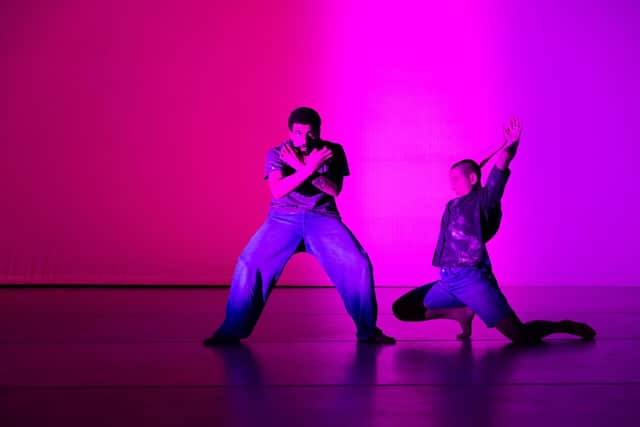Charlotte Mclean on Futuristic Folktales: 'it’s like we’re up the glen but on Mars'
Once we’re out in the world, finance usually dictates the kind of habitat we can afford to dwell in. To begin with, however, in a brief moment of true parity, we all occupy the same living space – a womb. It’s this commonality, coupled with the multifarious ways this part of the body is viewed and experienced, that inspired Charlotte Mclean’s new show, Futuristic Folktales.
A Highland dancer from a young age, 29-year-old Mclean left her Arbroath home to study at London Contemporary Dance School in London, before carving a career both at home and abroad. She came to prominence at the 2022 Edinburgh Festival Fringe, when her deeply personal solo show, And, packed a powerful punch (and garnered a 5-star Scotsman review in the process).
Advertisement
Hide AdIt was shortly after this that the idea for Futuristic Folktales was born, and a two-year gestation period followed. During this time, Mclean invited over 30 artists from a variety of nations and disciplines to join her in the research process. Despite being a compelling on-stage presence herself, she also made the decision to step aside and let dancers Orrow Bell and Astro Scheidegger take the spotlight.


“I’ve been in many different rehearsal processes and performances led by others that have been fantastic and amazing,” says Mclean, “but also ones that have been very difficult, rough and ugly, so I wanted to practice leading others. It’s very easy for me to direct myself and have an internal monologue, but with Futuristic Folktales I’ve been working on how I create with other people, collaborate and lead. And it’s exciting to hand over the baton, as it were, to Orrow and Astro who are both fantastic performers.”
Today’s modern dance scene is a very broad church, with the word “contemporary” becoming less and less defined. Ballet, hip hop, commercial, African and Asian dance have all been viewed through a contemporary dance lens – but Mclean may well be the only choreographer throwing Highland dance into the mix. “It’s a dance form that I grew up doing and it’s really important for me to research what Highland dance is and where it comes from,” she says, “then for me to share it widely with everyone, on stage, in dance classes, in workshops, with breakdancers, with elderly dance groups – I’ve done it all. And with Futuristic Folktales, we’ve managed to delve a little bit more into the history.”
If you’re picturing a Highland dancer in your head, they’re probably dressed in tartan, velvet and lace, feet beautifully pointed, with a technique as tight as the bun on their head. But it wasn’t always so. “Highland dancing was codified once ballet was invented,” explains Mclean. “Before that, it was this very rough jump to keep yourself warm, and with the introduction of ballet it became a very regal, positioned dance. So we have a bit of that in the show: hints of Highland dancing in the 1300s, today and in the future. Also, what it looks like on the bodies of these dancers who aren’t Scottish.”
With a history in ballet, contemporary dancer Bell took to Highland dancing with relative ease. For Swiss-born breakdancer Scheidegger, however, the response was quite different. Not least when he was introduced to the specially commissioned soundtrack for the piece, incorporating bagpipes, synthesiser and vocals. “When Astro first heard the bagpipes he was like ‘OK, I’m out of this project!’,” laughs Mclean. “But now he says that it’s gone from his head into his heart, which is really beautiful. And Malin Lewis, who created the music, has made this incredible soundscape of ethereal bagpipes. It’s so visceral and filmic, it’s like we’re up the glen but on Mars.”
Not only is Futuristic Folktales a homage to all things womb, it also dives into the art of storytelling across the centuries, looking forwards as well as backwards. “We’ve been looking at folktales from across the world and how those stories are passed down and told,” says Mclean, “and asking, what will the future look like beyond us? What folktales will our children’s children’s children tell about 2024? Will they be dark and filled with tales of war, exactly the same as 1,000 years ago? So that’s in the show as well.” With men, women, non-binary, transgender, parents and non-parents all feeding into the research, Mclean had a rich tapestry of thoughts and feelings about the humble yet mighty uterus to draw upon. “Some people didn’t want to talk about it, some did, some found it difficult, some had a dysphoria – it was a tender topic,” says Mclean. “But it’s been important to hear from all these different voices because the one thing that unites us all, is that we’ve all come from a womb. No matter what our personal relationship with that word is now, we were all in one.
Advertisement
Hide Ad“What’s important for me, especially with reproductive rights, is to show it all. We don’t say ‘we stand for this’ or ‘we’re against that’, because I don’t think there’s value in that on stage. Everyone is entitled to their own opinion and we should all respect that. It’s more about saying ‘hey, what are all these different things?’. We don’t name anything directly, which I think allows space for lots of different opinions and hopefully for people to discuss it afterwards.”
Futuristic Folktales, Tramway, Glasgow, 26 & 27 April and Dance Base, Edinburgh, 13-18 August